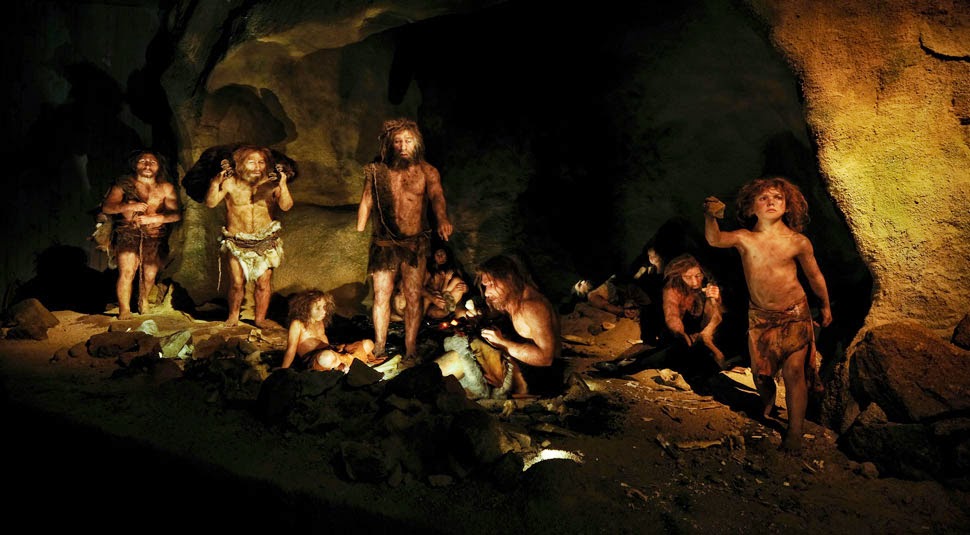7.11.14
The Museum of Neanderthal Man
It is a truth universally acknowledged that one never visits museums and tourist attractions located in our neighbourhood since it takes no effort whatsoever and we leave it to tourists who actually travelled to get here trough the rain and the storm. We can point directions to any curious visitor and talk about our fabulous national heritage but God forbid that we actually go there ourselves because our heads were brainwashed in the schools and besides, we know everything about it from TV quiz shows. Another thing is to visit museums around the world (specially on rainy days, so we can shop and eat there) because its something we can boast about to our friends back home. This is why it took me forever to visit Zagreb's History Museum which was actually 10 minutes walk from my house (and re-visited it several times since I don't live there), same for Amsterdam's Rijksmuseum or London's British Museum - I have lived in both towns and passed these buildings on daily basis before I actually decided to go inside. So now, 45 years after I plopped out in the world here in this particular part of Croatia, I finally went to see something that is in fact world-known and quite amazing - the Museum of Neanderthal Man.
You see, in the late 19th century locals in a small village of Zagorje region (beyond the hill towering above Zagreb) have discovered some strange bones in several caves and the news quickly spread all over Europe as Croatian archaeologist Kramberger came to conclusion these were remains of large group of Neanderthal people who apparently lived in these parts 100 000 years ago. Foreign scientists tried to contradict him, saying these skulls could be some abomination, mentally retarded persons and such, but this guy knew what he was talking about, besides there were also a lot of animal bones around and none of those we ever remember living here so findings were genuine and obviously ancient. The whole area became quite famous because of this and the name "caveman from Krapina" entered our language as description of anybody who is either ancient or backwards, or both.
The museum has been here for quite some time, but underwent radical re-organisation and re-building in 2010 when it was finally opened with lots of new ideas and computer animations. I was honestly very impressed with how much they did create here, considering that the core of the story is so small and obviously a lot of efforts went into making this museum interesting for visitors. First of all, the whole entrance is exciting because the road leads trough the Forrest where these ancient people actually roamed into quite spectacular, cave-looking large building that has two floors of different stories. Its really amazing that this has all been discovered under this sleepy little village, I mean it really put place on a world map. The story starts with little introduction to archaeologist who had discovered this and who he was, how it affected his life and made his career (there are some cute old black & white photos of him and even his school certificate when he was 12), than suddenly we see the very well done movie about beginning of not just our solar system but in fact big bang that created cosmos and how planets came to be - meteorites bombarding our planet, bringing not just destruction but water and life along. The Exhibition that goes on about beginning of life on Earth and than slowly, very slowly we actually encounter fossils, first animals, reptiles, dinosaurs (I did not know we had them here!), known mammals, first monkey-like creatures and eventually first humanoids that evolved into Neanderthals. We get to actually see a perfect life-like statues of creatures found in these caves nearby, reconstructed as they probably looked like (red haired!) and what they wore (leather loin covers), one of them lost hand and was healed, so obviously they protected and cared for each other.
Lots if interesting ideas and food for thoughts: we think we are now so civilised and sophisticated but human nature always made people loving, caring and protective (or cruel) towards each other. This tribe or clan or how they saw themselves clearly lived together and felt kinship, certain togetherness that kept them apart from other beings or invaders. They slept around the fire in these caves, they fought, hunted and died together, they even buried their loved ones after some deliberate rituals (skulls have strange carvings on foreheads, done after death) so there might even have been some beliefs involved. Why and how Neanderthal ever completely disappeared from Europe is one of the biggest unsolved mysteries, apparently our own Homo Sapiens replaced them completely - either we were more brutal and simply killed them off, ate them inter-married or simply the Ice Age was the end for them.The medieval picture at the end of exhibition was very poignant, it showed "dance of death" so popular during the Plague years and it symbolises the one and only certainty, the death itself. I like to think that Neanderthals were not all massacred but somehow got intermarried with Homo Sapiens and we still got their DNA even today - this was confirmed towards the end of exhibition where we see bodies of modern man compared to Neanderthal - there is a mirror between them - for some reason modern man was made to look very tall and statuesque but honestly my own body was far closer to Neanderthal!
p.s.
It just came to my mind that earlier this year I had visited another stone-age place in Orkney Islands above Scotland, so its really a nice coincidence how all of this came my way so spontaneously.
Subscribe to:
Post Comments (Atom)




No comments:
Post a Comment